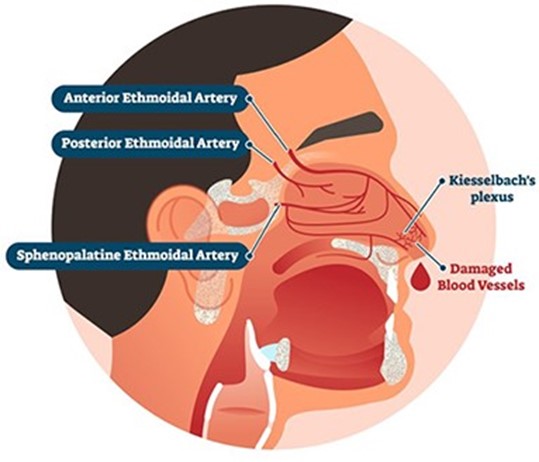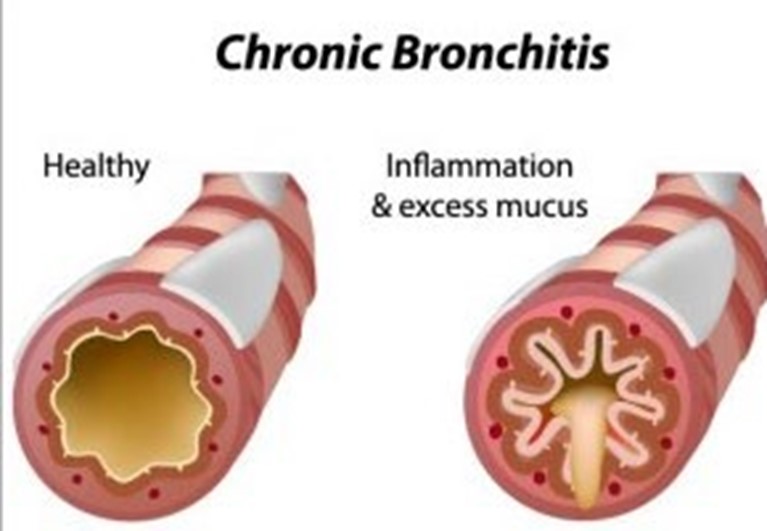A nurse is caring for a client who has hypertension and develops epistaxis. Which of the following actions should the nurse take? (Select all that apply)
Tilt the client's head backward
Move the client into high-Fowler's position
Apply pressure to the nares
Instruct the client to blow his nose
Place ice to the bridge of the client's nose
Correct Answer : B,C,E
These actions help to control bleeding, reduce blood pressure, and promote clotting.
a. Tilt the client's head backward. This is not recommended, as it can cause blood to drain into the throat and increase the risk of aspiration, nausea, or vomiting.
d. Instruct the client to blow his nose. This is not advisable, as it can dislodge any clots that have formed and worsen bleeding.

Nursing Test Bank
Naxlex Comprehensive Predictor Exams
Related Questions
Correct Answer is D
Explanation
Smoking cessation is the most effective way to prevent chronic bronchitis, which is a type of chronic obstructive pulmonary disease (COPD) characterized by inflammation and excess mucus production in the
bronchi. Smoking is the main cause of chronic bronchitis, as it damages the cilia and mucous membranes of the airways, leading to chronic cough, sputum, and infection. Quitting smoking can reduce the risk of developing or worsening chronic bronchitis and improve lung function and quality of life.
a) Regular moderate exercise is beneficial for preventing chronic bronchitis, but not as effective as smoking cessation. Exercise can improve cardiovascular and respiratory health, increase oxygen delivery to the tissues, and enhance immune function. However, exercise alone cannot reverse the damage caused by smoking or prevent further deterioration of the airways.
b) Maintenance of ideal weight is beneficial for preventing chronic bronchitis, but not as effective as smoking cessation. Maintaining a healthy weight can reduce the workload on the heart and lungs, prevent obesity-related complications, and improve self-esteem and well-being. However, weight management alone cannot restore the normal structure and function of the airways or prevent chronic inflammation and mucus production.
c) Annual influenza immunization is beneficial for preventing chronic bronchitis, but not as effective as smoking cessation. Influenza immunization can protect against viral infections that can trigger or exacerbate chronic bronchitis symptoms, such as fever, cough, wheezes, and dyspnea. However, influenza immunization cannot prevent other causes of chronic bronchitis, such as bacterial infections, environmental pollutants, or genetic factors.

Correct Answer is ["A","C","E"]
Explanation
These clients have impaired swallowing, gag reflex, or level of consciousness, which increase their risk of aspiration while eating.
The other options are not correct because:
b. A client who has had prolonged diarrhea does not have a direct risk factor for aspiration, as diarrhea affects the lower gastrointestinal tract and not the upper airway or esophagus.
d. A client who has lactose intolerance does not have a risk factor for aspiration, as lactose intolerance causes abdominal cramps, bloating, gas, or diarrhea when consuming dairy products, but does not affect the ability to swallow or protect the airway.
Whether you are a student looking to ace your exams or a practicing nurse seeking to enhance your expertise , our nursing education contents will empower you with the confidence and competence to make a difference in the lives of patients and become a respected leader in the healthcare field.
Visit Naxlex, invest in your future and unlock endless possibilities with our unparalleled nursing education contents today
Report Wrong Answer on the Current Question
Do you disagree with the answer? If yes, what is your expected answer? Explain.
Kindly be descriptive with the issue you are facing.
